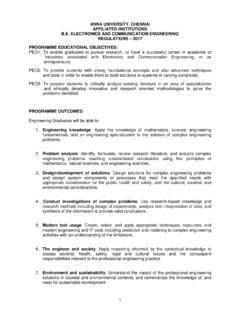Transcription of Introduction to Photonic Crystals: Bloch’s Theorem, Band …
1 Introduction to Photonic Crystals: Bloch s Theorem, Band Diagrams, and Gaps(But No Defects)Steven G. Johnson and J. D. Joannopoulos, MIT3rd February 20031 IntroductionPhotonic crystals are periodically structured electromagnetic media, generallypossessingphotonic band gaps: ranges of frequency in which light cannot prop-agate through the structure. This periodicity, whose lengthscale is proportionalto the wavelength of light in the band gap, is the electromagnetic analogue ofa crystalline atomic lattice, where the latter acts on the electron wavefunctionto produce the familiar band gaps, semiconductors, and so on, of solid-statephysics. The study of Photonic crystals is likewise governed by the Bloch-Floquet theorem, and intentionally introduced defects in the crystal (analo-gous to electronic dopants) give rise to localized electromagnetic states: linearwaveguides and point-like cavities.
2 The crystal can thus form a kind of per-fect optical insulator, which can confine light losslessly around sharp bends,in lower-index media, and within wavelength-scale cavities, among other novelpossibilities for control of electromagnetic phenomena. Below, we introducethe basic theoretical background of Photonic crystals in one, two, and threedimensions (schematically depicted in Fig. 1), as well as hybrid structures thatcombine Photonic -crystal effects in some directions with more-conventional in-dex guiding in other directions. (Line and point defects in Photonic crystals arediscussed elsewhere.)Electromagnetic wave propagation in periodic media was first studied byLord Rayleigh in 1887, in connection with the peculiar reflective properties of acrystalline mineral with periodic twinning planes (across which the dielectrictensor undergoes a mirror flip).
3 These correspond to one-dimensional photoniccrystals, and he identified the fact that they have a narrow band gap prohibitinglight propagation through the planes. This band gap is angle-dependent, dueto the differing periodicities experienced by light propagating at non-normalincidences, producing a reflected color that varies sharply with angle. (A similareffect is responsible for many other iridescent colors in nature, such as butterflywings and abalone shells.) Although multilayer films received intensive study1 2-D periodic in two directions 3-D periodic in three directions 1-D periodic in one directionFigure 1: Schematic depiction of Photonic crystals periodic in one, two, andthree directions, where the periodicity is in the material (typically dielectric)structure of the crystal.
4 Only a 3d periodicity, with a more complex topologythan is shown here, can support an omnidirectional Photonic bandgapover the following century, it was not until 100 years later, when Yablonovitchand John in 1987 joined the tools of classical electromagnetism and solid-statephysics, that the concepts of omnidirectional Photonic band gaps in two andthree dimensions was introduced. This generalization, which inspired the name Photonic crystal, led to many subsequent developments in their fabrication,theory, and application, from integrated optics to negative refraction to opticalfibers that guide light in Maxwell s Equations in Periodic MediaThe study of wave propagation in three-dimensionally periodic media was pi-oneered by Felix Bloch in 1928, unknowingly extending an 1883 theorem inone dimension by G.
5 Floquet. Bloch proved that waves in such a medium canpropagate without scattering, their behavior governed by a periodic envelopefunction multiplied by a planewave. Although Bloch studied quantum mechan-ics, leading to the surprising result that electrons in a conductor scatter onlyfrom imperfections and not from the periodic ions, the same techniques can beapplied to electromagnetism by casting Maxwell s equations as an eigenproblemin analogue with Schr odinger s equation. By combining the source-free Fara-day s and Ampere s laws at a fixed frequency , time dependencee i t,one can obtain an equation in only the magnetic field~H:~ 1 ~ ~H=( c)2~H,(1)where is the dielectric function (x, y, z) andcis the speed of light.
6 Thisis an eigenvalue equation, with eigenvalue ( /c)2and an eigen-operator~ 21 ~ that isHermitian(acts the same to the left and right) under the innerproduct ~H ~H between two fields~Hand~H . (The two curls correspondroughly to the kinetic energy and 1/ to the potential compared to theSchr odinger Hamiltonian 2+V.) It is sometimes more convenient to insteadwrite ageneralizedHermitian eigenproblem in the electric field~E,~ ~ ~E=( /c)2 ~E, which separates the kinetic and potential terms. Electric fields thatlie in higher , potential, will have lower ; this is discussed furtherin the context of the variational theorem of Eq. (3).Thus, the same linear-algebraic theorems as those in quantum mechanicscan be applied to the electromagnetic wave solutions.
7 The fact that the eigen-operator is Hermitian and positive-definite (for real >0) implies that theeigenfrequencies are real, for example, and also leads to orthogonality, vari-ational formulations, and perturbation-theory relations that we discuss furtherbelow. An important difference compared to quantum mechanics is that thereis atransversality constraint: one typically excludes~ ~H6= 0 (or~ ~E6= 0)eigensolutions, which lie at = 0; solutions with free magnetic(or electric) charge are Bloch waves and Brillouin zonesA Photonic crystal corresponds to a periodic dielectric function (~x) = (~x+~Ri) for someprimitive lattice vectors~Ri(i= 1,2,3 for a crystal periodic inall three dimensions).
8 In this case, the Bloch-Floquet theorem for periodiceigenproblems states that the solutions to Eq. (1) can be chosen of the form~H(~x) =ei~k ~x~Hn,~k(~x) with eigenvalues n(~k), where~Hn,~kis aperiodicenvelopefunction satisfying:(~ +i~k) 1 (~ +i~k) ~Hn,~k=( n(~k)c)2~Hn,~k,(2)yielding a different Hermitian eigenproblem over the primitive cell of the lat-tice at each Bloch wavevector~k. This primitive cell is a finite domain if thestructure is periodic in all directions, leading to discrete eigenvalues labelled byn= 1,2, . These eigenvalues n(~k) are continuous functions of~k, formingdiscrete bands when plotted versus the latter, in a band structure or dis-persion diagram both and~kare conserved quantities, meaning that a banddiagram maps out all possible interactions in the system.
9 (Note also that~kisnot required to be real; complex~kgives evanescent modes that can exponen-tially decay from the boundaries of a finite crystal, but which cannot exist inthe bulk.)Moreover, the eigensolutions are periodic functions of~kas well: the solutionat~kis the same as the solution at~k+~Gj, where~Gjis a primitivereciprocallattice vectordefined by~Ri ~Gj= 2 i,j. Thanks to this periodicity, one needonly compute the eigensolutions for~kwithin the primitive cell of this reciprocal3lattice or, more conventionally, one considers the set of inequivalent wavevec-tors closest to the~k= 0 origin, a region called the first Brillouin zone. Forexample, in a one-dimensional system, whereR1=afor some periodicityaandG1= 2 /a, the first Brillouin zone is the regionk= a a; all otherwavevectors are equivalent to some point in this zone under translation by amultiple ofG1.
10 Furthermore, the first Brillouin zone may itself be redundant ifthe crystal possesses additional symmetries such as mirror planes; by eliminat-ing these redundant regions, one obtains theirreducible Brillouin zone, a convexpolyhedron that can be found tabulated for most crystalline structures. In thepreceding one-dimensional example, since most systems will have time-reversalsymmetry (k k), the irreducible Brillouin zone would bek= 0 familar dispersion relations of uniform waveguides arise as a special caseof the Bloch formalism: such translational symmetry corresponds to a perioda 0. In this case, the Brillouin zone of the wavevectork(also called ) isunbounded, and the envelope function~Hn,kis a function only of the The origin of the Photonic band gapA complete Photonic band gap is a range of in which there are no propa-gating (real~k) solutions of Maxwell s equations (2) for any~k, surrounded bypropagating states above and below the gap.





